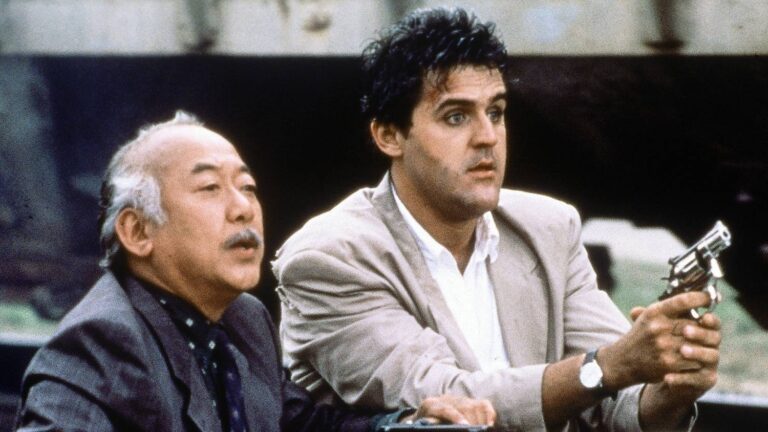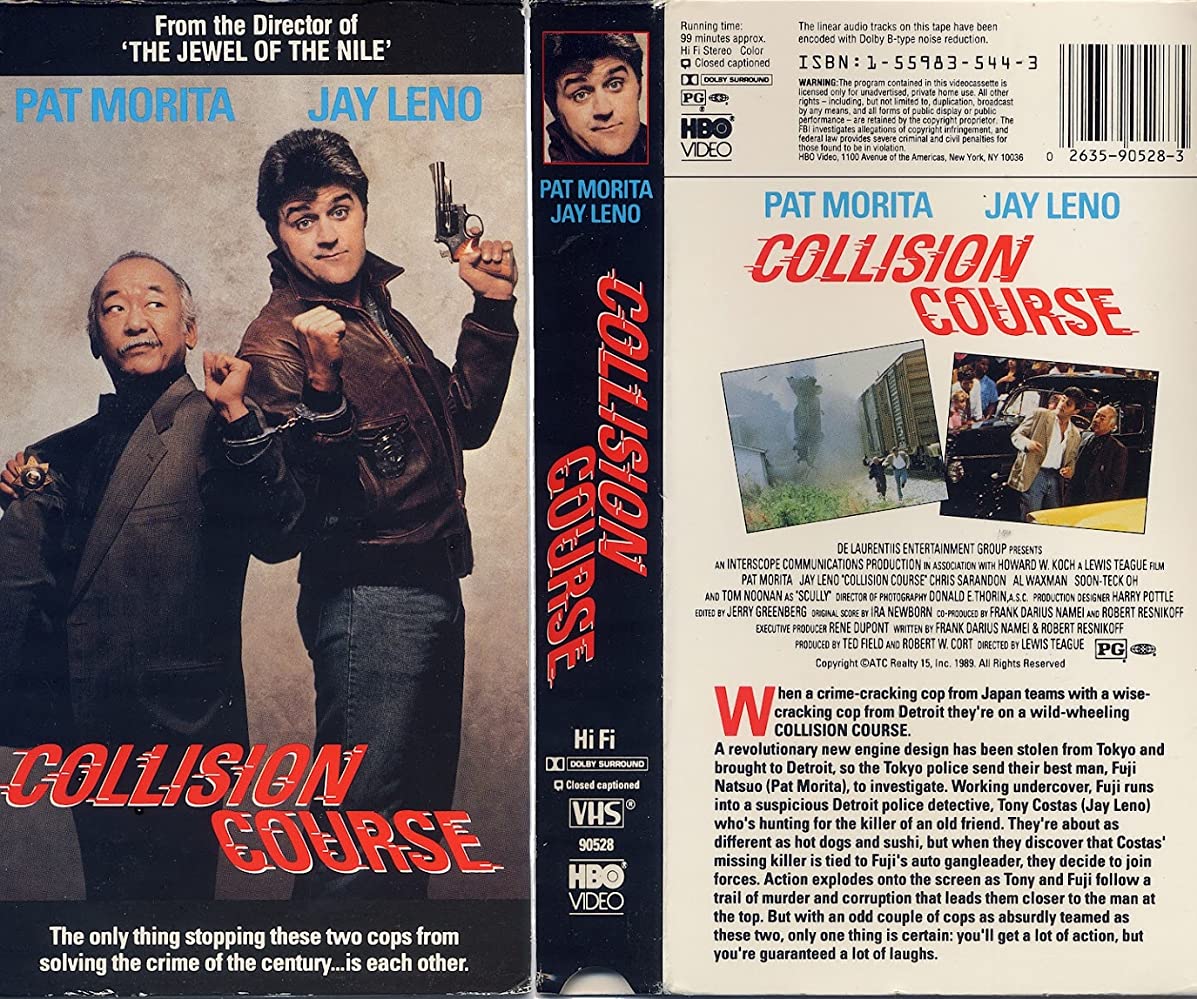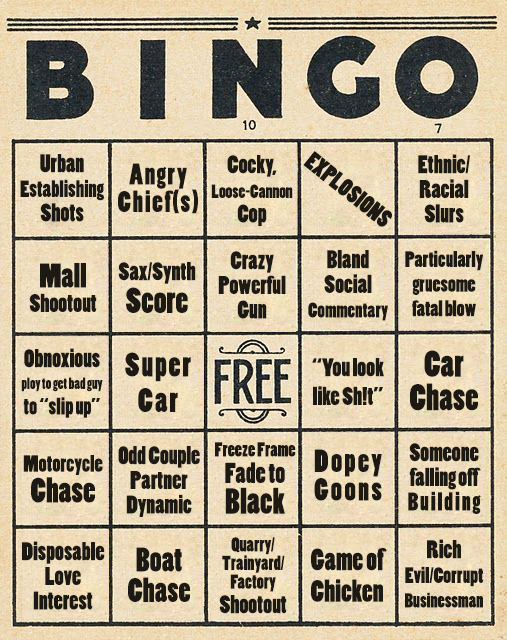
The Action Duo that no one asked for, but we all ultimately deserved.

Very few films in the history of cinema have truly lived up to their titles quite like Collision Course. From its humble beginnings to it catastrophic release and finally, to its vanishing legacy, the Jay Leno and Pat Morita vehicle never stood a chance. It was leased on bad credit, puttered around on its bald tires for a little while, hit a few speed bumps, and then simply ran out of gas. Instead of calling for a tow, Leno and his fellow travelers left it on the side of the road where it sits today, rusting and rotting away in a dirty forgotten alley. The sad story of the buddy-cop comedy that couldn’t reflects the decay of the powerful independent studios that brought us some of the best action movies that we cherish today.
Before the memorial service begins, let’s have a wake and remember the good times. Reminisce about that crazy ride when the former Tonight Show Host and Karate Kid’s Mr. Miyagi teamed up to fight international industrial espionage, corporate corruption, and violent gangsters.
Collision Course borrowed and stole from every action-comedy movie of the time. You could make a bingo game out of it. Each square represents your favorite trope from the genre, like this one here.
There are so many more but it’s fun coming up with your own. This recipe for crowd-pleasing entertainment was tried and true when the production wrapped in 1987 but the ingredients were well past their expiration date in 1992 when Collision Course was unceremoniously dumped on VHS. That’s right, a five-year gap, making it the last 80s action comedy ever released. More on that to come.
It may not bring anything new to the table but Collision Course delivers a heaping helping of cinematic comfort food. It has the story dynamic of Red Heat, Lethal Weapon’s character chemistry, a Police Academy sequel’s zany hijinks, Beverly Hills Cop’s Detroit, and a slice of the social commentary in Ron Howard’s Gung Ho. If you’re an action-comedy fan and grew up with these types of movies, you’ll reflexively love Collision Course.
Surprisingly Ultimate Action
One of the most important factors in giving movies like these the time of day is the quality of its action scenes. Again, like the rest of the film, they are slightly above adequate but highly entertaining. The underutilized rocket gun plays a critical role in jumpstarting the action and plays a significant part in the plot. The rocket gun really deserves its own standalone film. From there, mild chase scenes ensue, feeble strong-arming sorta’ intimidates, and the occasional bowl-a-rama brawl breaks out. These scenes are sprinkled throughout the movie to hold the viewer’s interest.
The emphasis is more on comedy, which plays to Leno’s and Morita’s strengths. In one scene, Morita’s character even admits that he doesn’t know how to fight or shoot despite being a seasoned police officer. The real action is saved for the third act with some motor city mayhem, a competently executed chase sequence, and one of the best games of on-screen chicken ever conceived.
This scene deserves special recognition. I suppose this is the character’s redemption after “chickening out” at the bowling alley. The ill-prepared and undertrained middle-aged man squares off against the mob boss and his speeding Buick. Man vs. machine like you’ve never seen. With a samurai scream, Morita charges at the oncoming vehicle and neutralizes his enemy with a flying double kick through the windshield. Pat really sticks the landing even if the visual effects are a bit clunky.
Aside from these highlights, the action is treated almost like an afterthought. On a technical level, the chase scenes and standoffs are fine but they lack energy and fizzle out at the end. You’re left thinking, “Ok that was fun, what’s next?” Uh oh, there goes Mr. Miyagi running around with a bag on his head, watch out!
Solid Story and Editing

The action adequately drives the characters from one location to the next. It’s a basic McGuffin plot. A secret prototype for a new-fangled turbo charger is stolen from a car company in Japan and the authorities believe it was smuggled into the US. Sure enough, Mr. Oshima, played by another Karate Kid veteran Danny Kamekona, plans to sell it to a crooked CEO of a US auto company. The unscrupulous businessman’s hired goons go a little too far in the negotiation process transfer the ill-gotten car part and they create an international incident: a double homicide, and with no turbo charger to show for it.
The Japanese police send a lone and defenseless Investigator Fujitsuka Natsuo, Pat Morita, to covertly recover the turbo charger. Jay Leno’s cartoonish Tony Costas quickly foils Natsuo’s efforts but the two predictability team up to uncover the scheme and solve the case.
It’s the kind of outlandish narrative you’d expect from this caliber of movie but it works to tie the characters and motivations together. The audience can easily figure out what’s going on and, generally, why the characters are reacting the way they are, albeit in ridiculous ways. The story beats are precisely timed to hold the popcorn munchers’ attention until the inevitable conclusion. The movie fittingly ends with a rare split-screen/freeze frame of our two heroes as saxophones blare through the credits.
Shane Black’s ‘Lethal Weapon 2’: The Darkest Buddy Cop Movie That Never Got Made
Characters Big and Small

The tight script allows moments for Leno and Morita to awkwardly bond over one glass of whiskey and driving to the next lead. Although Leno has absolutely no range, his chemistry with Morita and their riffing off each other actually work surprisingly well. To be fair, Leno has a cheesy likeable quality anyway, so you can forgive this one-note performance.
The rest of the cast is a who’s who of 80s supporting players. Ernie Hudson is Tony Costas’ third-wheel of a partner, Chris “Prince Humperdinck” Sarandon is the mob boss, Tom Noonan who we all know and love from Robocop 2 is goon #1, and goon #2 is the big loveable oaf, Randall “Tex” Cobb. All these guys deliver fine performances despite their simplistic characters. They couldn’t have found a better or more appropriate cast for the quintessential buddy-cop flick.
The one bingo square that’s missing is the disposable love interest. “Disposable love interest” is supposed to keep the lead grounded and open him up to his expository back story, adding much needed depth and insight into his character. Jay Leno harasses several women, “looking for some action” as the title song suggests, but they rightly put him off at every turn. It’s kind of refreshing actually but we never get to know the “real” Tony.
Without the lady friend/hook-up element, most writers can’t figure out how to develop characters in action movies. They don’t even bother with Leno, Morita, or anyone else for that matter. What you see is what you get.
Jean-Claude Delivers Maximium Van Damage in ‘Desert Heat’ (1999)
Themes and Watchability
Collision Course touches on a hot topic for 1987: the rise of Japanese and the fall of American auto manufacturing in the mid- to late 80s. The dynamic sped up Detroit’s dramatic economic decline and the rust belt’s working-class openly resented their overseas competitors.
The subject was explored more thoroughly in Gung Ho, starring Michael Keaton and Norm from Cheers. Collision Course provides a less nuanced commentary and explores the sensitive topic through a steady stream of derogatory remarks directed at Morita’s nationality and race. The bigotry is played for laughs. This was probably a big turn-off for audiences by ‘92 and much of the dialogue would be viewed as downright toxic today.
Despite the crass attitudes that make the audience wonder if any of these characters have ever seen an Asian person before, Collision Course clumsily tries its best to make a point. While featuring several shots of urban decay, Leno admits that perhaps the American worker had lost his mojo. Social messages in films like these often come across as ham-fisted but can sometimes elevate the work. Swing and a miss for this novice writing staff.
Overall, Collision Course is very watchable and holds up after a repeat viewing, especially if you’re into best-of-the-worst entertainment. The cheesy characters and dialogue coupled with modest action and decent chase scenes are as endearing as any Chuck Norris schlock or Robert Z’dar tax write-off. It’s a movie you can both laugh at and with while groaning at the cornball antics. Although it may not be the sum, it’s at least the median of all its action-comedy predecessors’ parts.
Critics weren’t as forgiving, and combined with the bungled release, Collision Course ran right into a brick wall. It was largely viewed as a tired, cash-grab aping off of far better movies in the genre. The VHS distributor even offered to give video rental customers’ money back if “you were not completely entertained by Collision Course” for one year after its release.
It effectively ended Leno’s acting career but he wasn’t complaining. He landed the Tonight Show gig in 1992 when Collision Course coincidentally went straight-to-video. He later disavowed the film and let his guests rip on him for making it. His performance and the movie itself are not exceptionally terrible, so completely trashing the production is a tad unfair. Far worse have been elevated to cult status. Ultimately, Collision Course’s failure is a result of something bigger; a showbiz calamity of which we still feel the repercussions to this day. Read part two to find out how Collision Course became intertwined with the fate of semi-independent film production in the 80s and 90s.